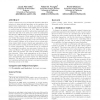Free Online Productivity Tools
i2Speak
i2Symbol
i2OCR
iTex2Img
iWeb2Print
iWeb2Shot
i2Type
iPdf2Split
iPdf2Merge
i2Bopomofo
i2Arabic
i2Style
i2Image
i2PDF
iLatex2Rtf
Sci2ools
160
click to vote
STOC
2012
ACM
2012
ACM
Minimax option pricing meets black-scholes in the limit
Option contracts are a type of financial derivative that allow investors to hedge risk and speculate on the variation of an asset’s future market price. In short, an option has a particular payout that is based on the market price for an asset on a given date in the future. In 1973, Black and Scholes proposed a valuation model for options that essentially estimates the tail risk of the asset price under the assumption that the price will fluctuate according to geometric Brownian motion. A key element of their analysis is that the investor can “hedge” the payout of the option by continuously buying and selling the asset depending on the price fluctuations. More recently, DeMarzo et al. proposed a more robust valuation scheme which does not require any assumption on the price path; indeed, in their model the asset’s price can even be chosen adversarially. This framework can be considered as a sequential two-player zero-sum game between the investor and Nature. We analyze the ...
Algorithms | Computer Science Division | Geometric Brownian Motion | STOC 2012 | University Of California Berkeley |
| Added | 28 Sep 2012 |
| Updated | 28 Sep 2012 |
| Type | Journal |
| Year | 2012 |
| Where | STOC |
| Authors | Jacob Abernethy, Rafael M. Frongillo, Andre Wibisono |
Comments (0)

